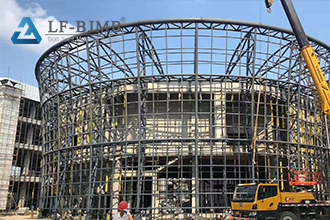Steel structure pipe joist needs to pay attention to the following key points when welding:

1. Welding order:
1.1 Welding should follow a certain order, usually, the middle node is welded first, and then the nodes at both ends of the joist are expanded.
1.2 This helps to avoid the size deviation between the nodes of the joist caused by the accumulation of weld shrinkage to one end.
1.3 It should not be welded at both ends of the same web at the same time, and the nodes connected with the lower chord should be soldered first, and then the nodes associated with the upper chord should be welded.
2. Weld seam size:
2.1 The weld seam size of the pipe truss must strictly conform to the calculated thickness value or weld foot size required by design.
2.2 There should not be too much overlap in welding heightening, because it may produce large welding residual stress.
2.3Weld bevel and clearance:
When the root clearance of the weld bevel is greater than the standard value of 1.5mm or more, the weld foot size should be increased according to the value of the excess clearance.
If the gap is greater than 5mm, the end or interface should be first trimmed with the surfacing and grinding method of surfacing the weld channel to reduce the weld gap.
3. The preparation before welding:
3.1 Confirm that the processing quality and process requirements of the welded parts are by the relevant standards, and carry out the necessary testing and test welding.
3.2 Clean up the welding site to ensure that the welding ground is flat, clean, and free of obstacles.
3.3 The welding environment must be kept dry to avoid the influence of bad weather.
3.4 Take appropriate safety measures to prevent fire and personnel injury.
4. The choice of welding materials:
4.1 Welding materials must meet the design specifications and standard requirements, the appearance of no damage, and internal defects.
4.2 Welding material chemical composition, mechanical properties, shrinkage, thermal deformation tensile strength, and other indicators also need to meet the requirements.
5. Welding quality control:
5.1 Strictly control the relative position of the welded parts of the size, to ensure that the welding is carried out only within the qualified range.
5.2 To prevent cracks, should choose the appropriate welding process parameters and welding procedures, avoid the use of high current, and do not suddenly turn off the flame, weld joints should be lapped 10 ~ 15mm.
5.3 It is not allowed to move and knock the weldment during welding.
5.4 Welding rods need to be baked according to the specified temperature and time, the welding area must be cleaned up, choose the appropriate welding current, and reduce the welding speed, so that the gas in the molten pool completely escapes to reduce surface porosity.
6. Check and acceptance:
After completing the welding, strict inspection and acceptance should be carried out to ensure that the quality of the weld meets the requirements, without cracks, slag, porosity, and other defects.
If non-conforming products are found, timely measures should be taken for rework or scrapping. The above are the key points that need to be paid attention to when welding steel pipe trusses.











 About Us
About Us 2024-06-05
2024-06-05


